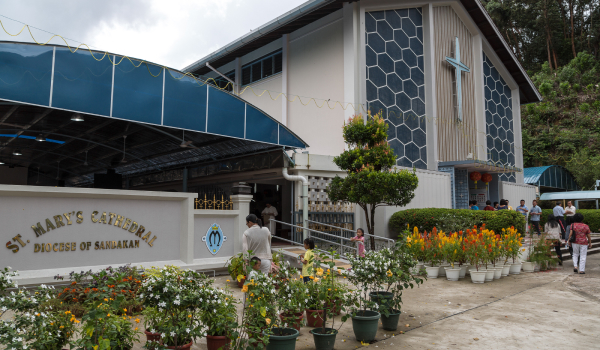
The diocese of Sandakan is located on the east coast of the "Land Below the Wind" - north of Borneo Island in the state of Sabah. When it became a diocese in 2007 it covered the Sandakan and Tawau divisions of Sabah comprising the towns of Sandakan, Kinabatangan, Beluran, Lahad Datu, Kunak, Semporna and Tawau. It is the largest of the three dioceses in Sabah, covering an area of 43,110 square kilometers or 58.3 percent of Sabah's territory. The Sandakan division has approximately 19.4 percent of Sabah's total population while the Tawau division has 26 percent. Most of the residents are made up of the Chinese, Dusuns, Kadazans, Malays, Muruts, Suluks, Bajaus, Ida'an, Tidong, Bugis, Filipinos and Indonesians.
Sandakan, the second largest city in Sabah, is located on the north-eastern coast of Borneo and is the administrative centre of the Sandakan division and was the former capital of British North Borneo. It is known as the gateway for ecotourism destinations in Sabah, such as the Sepilok Orang Utan Sanctuary, Turtle Islands Park, Kinabatangan River and Gomantong Caves.
Sandakan was the first European settlement founded by William Clarke Cowie, a Scottish gun smuggler from Glasgow who received permission from the Sultan of Sulu to establish a small trading base. Cowie called his settlement Sandakan, which in Tausug (Suluk) means the place that was pawned but it soon came to be known as "Kampung German" after the large number of Germans who also set up posts there.
The settlement was part of the lease Austro-Hungarian Consul Baron von Overbeck acquired from the Sultan of Sulu in 1878. After the lease was purchased by von Overbeck's British partner Alfred Dent, Kampung German was accidentally razed to the ground on June 15, 1879. The new British Resident William Burges Pryer decided not to rebuild the village but to move to Buli Sim Sim on June 21, 1879. He named his new settlement Elopura, which means Beautiful City. A few years later the name was changed back to Sandakan. The name Elopura still refers to a region of Sandakan.
Sandakan in the early years served as a major port for the settlers in Sabah and most Chinese came in to the state through this port. At one point of time Sandakan had numerous Chinese settlers and was hence called "Little Hong Kong". Due to the settlement of people from various countries, Sandakan was rich with early traces of foreign cultures.
In 1883, the capital of the British North Borneo Company was moved from Kudat to Sandakan. In the mid 1930s Sandakan's timber export reached the record figure of 180,000 cubic metres, making it the largest timber-exporting port of tropical wood in the world. At the height of the timber boom, Sandakan boasted that it had the highest concentration of millionaires anywhere on earth.
The Japanese occupation of Sandakan during World War II began on Jan. 19, 1942, and lasted until a brigade of the Australian 9th Division liberated it on Oct. 19, 1945. The Japanese administration restored the name Elopura for the town. One of the atrocities of WWII was the Sandakan Death Marches, a series of forced marches from Sandakan to Ranau (160 miles) which resulted in the deaths of more than 3,600 Javanese civilian slave labourers and 2,400 Allied prisoners of war. The prisoners who did not die en route to Ranau were crammed into unsanitary huts; most of those survivors either died from dysentery or were killed by prison guards. By the end of the war, of all the prisoners who had been incarcerated at Sandakan and Ranau, only six Australians survived, all of whom had escaped. When the war ended, Sandakan was totally destroyed, partly from the Allied bombings and partly by the Japanese. As a result, when North Borneo became a British Crown Colony in 1946, the capital was shifted to Jesselton, now known as Kota Kinabalu or simply KK.
Sandakan remains Sabah's second most important port, after Kota Kinabalu. The port is important for palm oil, tobacco, cocoa, coffee, manila hemp and sago exports. Sandakan is also one of the most bustling towns in East Malaysia. The once dominant timber industry is now relatively small. It is likely tourism will become important to the town's future.
In recent years, businesses have shifted their operations away from the town center to the suburbs due to the presence of undocumented immigrants in the town. In January 2003, the Sandakan Harbour Square, an urban renewal project, was launched in an attempt to revive the town center as the commercial hub in Sandakan.
The most practical way for the short term visitor to get into Sandakan is by air. Sandakan Airport is connected directly daily with Kuala Lumpur, and to Kota Kinabalu.